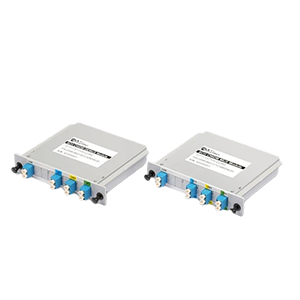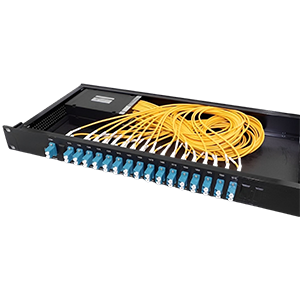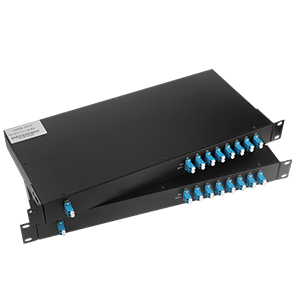Welcome to this blog! I will discuss with you why Wavelength Division Multiplexing (WDM) technology is so popular and attracts so much attention. We’ll review the fundamentals and workings of WDM technology and gain insight into how it can meet growing demands for high bandwidth, provide flexibility and scalability, and improve cost-effectiveness and resource utilization.
Wavelength Division Multiplexing (WDM) technology is a popular and concerned technology in the field of optical fiber communications. As modern society’s demand for high-speed, high-bandwidth networks continues to grow, WDM technology, as an effective solution, plays an important role in realizing large-capacity and high-efficiency data transmission. This article will explore why WDM technology is so popular and attracts attention, as well as its advantages and applications.
WDM technology is based on the principle of wavelength multiplexing of light. By using multiple wavelengths for parallel transmission in optical fibers, it achieves simultaneous transmission of multiple independent communication channels. This technology allows large amounts of data to be transmitted simultaneously in fiber optic communication systems, greatly increasing the bandwidth and capacity of the network. Compared with traditional single-wavelength communication systems, WDM technology can increase fiber utilization to a higher level and meet the needs of modern communications.
Basic principles of WDM technology
Wavelength Division Multiplexing (WDM) technology is a communication technology based on the principle of wavelength multiplexing of light. It achieves parallel transmission of multiple independent communication channels by simultaneously transmitting optical signals of multiple wavelengths in optical fibers and combining them in one optical fiber for transmission. The following is a brief review of the basic principles and workings of WDM technology:
1. Basic principles:
WDM technology uses the wavelength characteristics of light to multiplex optical signals of different wavelengths so that they can be transmitted in the same optical fiber without interfering with each other. The wavelength of an optical signal is in the visible and infrared range and is usually expressed in nanometers (nm). WDM technology uses a wavelength division multiplexer (Wavelength Multiplexer) to combine optical signals of multiple wavelengths to form a composite optical signal, which is then transmitted through optical fiber. At the receiving end, a wavelength demultiplexer is used to decompose the composite optical signal into the original wavelength signal for interpretation and processing by the corresponding receiving equipment.
2. Working method:
WDM technology realizes parallel transmission and multi-channel communication by transmitting optical signals of multiple wavelengths at the same time. Different communication channels are identified and distinguished using different wavelengths, so they can transmit simultaneously in the fiber without interfering with each other. Each channel can transmit data independently, enabling efficient bandwidth utilization and increased data transmission capacity. This enables WDM technology to meet the needs of large-capacity and high-speed data transmission.
By transmitting optical signals of multiple wavelengths simultaneously, WDM technology can improve bandwidth utilization and data transmission capacity. Compared with traditional single-wavelength communication systems, WDM technology transmits multiple signals simultaneously in the same optical fiber, making full use of the bandwidth resources of the optical fiber. Each wavelength channel can carry independent communication signals, so data transmission on multiple communication channels can be carried out simultaneously. This significantly increases the total bandwidth and data transmission capacity of the network to meet growing data demands.
Increase in demand for high bandwidth
With the rapid development of the Internet and data communications, the demand for high bandwidth continues to increase. This is driven by the following factors:
-
Big data applications: With the rise and application of big data technology, more and more data are generated, collected and processed. Applications such as big data analysis, cloud computing, and artificial intelligence have very high demands for high bandwidth. Processing huge data sets, conducting real-time analysis and transmitting large volumes of data require high-bandwidth networks to support it.
-
HD video and streaming media: HD video, video conferencing and streaming media services are becoming increasingly popular, and user demand for high-quality video and audio content is increasing. High-definition video and streaming applications place high demands on network bandwidth, especially when multiple users are accessing, downloading, or streaming video at the same time.
-
Mobile communications and wireless networks: The popularity of mobile devices and the development of wireless networks have brought explosive growth to mobile communications. Users carry out high-speed data transmission, multimedia content access and real-time communication through mobile devices such as smartphones and tablets, and their demand for high-bandwidth networks is becoming increasingly urgent.
-
Internet of Things (IoT): The Internet of Things connects various devices and sensors, enabling interconnection and data interaction between devices. With the increase in IoT devices, data generated by a large number of sensors needs to be transmitted and processed, and the need for high-bandwidth networks has become particularly important in IoT applications.
WDM technology plays an important role in meeting this high bandwidth demand. By transmitting optical signals of multiple wavelengths simultaneously in optical fibers, WDM technology can achieve large-capacity data transmission capabilities. Each wavelength channel can carry independent communication signals, so data transmission on multiple communication channels can be carried out simultaneously. This enables WDM technology to meet the high bandwidth needs in fields such as big data applications, high-definition video, mobile communications and the Internet of Things.
The high capacity and high bandwidth characteristics of WDM technology enable the network to carry more data traffic, provide faster data transmission speeds and higher bandwidth utilization. This is of great significance to all areas of modern society, including business, education, medical care, entertainment, etc. By adopting WDM technology, network operators and service providers can meet users’ needs for large-capacity data transmission and provide faster and more reliable network connections and services.
Advantages of flexibility and scalability
WDM technology is flexible and scalable in network design and expansion, allowing it to adapt to changing communication needs. The following is a discussion on the flexibility and scalability of WDM technology:
1. Flexibility:
The flexibility of WDM technology is reflected in the following aspects:
- Multiple wavelength support: WDM technology can support optical signal transmission of multiple wavelengths at the same time. This means that in network design, the number of wavelengths can be increased or decreased as needed to accommodate different capacity and bandwidth requirements.
- Protocol transparency: WDM technology is transparent to the transmitted data protocol and is not restricted by specific protocols. This allows the network to support various types of communications and data transfers, including Ethernet, Fiber Channel, storage area networks, and more.
- Compatibility: WDM technology is compatible with existing network equipment and infrastructure. It can be combined with other fiber optic transmission technologies such as SONET/SDH to achieve higher bandwidth and capacity.
2. Scalability:
The scalability of WDM technology allows the network to be expanded and upgraded as needed to adapt to growing communication needs. Here are a few key aspects of scalability:
- Wavelength increase: By increasing the number of wavelengths in a wavelength division multiplexer, the capacity and bandwidth of the network can be expanded. New wavelengths can be used for additional communication channels, thereby providing more bandwidth resources.
- Core density improvement: By increasing the core density in optical fibers, more communication channels and greater transmission capacity can be achieved. This can be achieved by improving fiber manufacturing technology or adopting higher-level WDM technologies such as dense wavelength division multiplexing (DWDM).
- Flexible configuration: WDM technology allows wavelengths to be configured and reallocated according to needs. This means that wavelength resources can be dynamically allocated and managed based on actual communication needs to best meet current capacity needs.
By adding or subtracting wavelengths in a wavelength division multiplexer, the capacity and demand of the network can be adjusted. When communication needs increase, the number of wavelengths can be increased to provide more bandwidth and capacity. Conversely, when demand decreases, the number of wavelengths can be reduced to save resources and improve network efficiency. This flexibility enables the network to dynamically adjust and optimize according to actual needs, ensuring efficient utilization and adaptability of network resources.
Improved cost effectiveness and resource utilization
WDM technology has significant advantages in improving resource utilization and reducing communication costs. The following is an explanation of the advantages of WDM technology in this regard:
1. Improvement of resource utilization:
-
Maximized utilization of optical fiber resources: WDM technology maximizes the utilization of optical fiber resources by transmitting multiple signals in optical fibers. Traditional single-channel optical fiber transmission can only utilize a small part of the bandwidth of the optical fiber, while WDM technology can transmit signals of multiple wavelengths simultaneously, making full use of the entire bandwidth of the optical fiber. This allows the network to transmit more data traffic based on the same optical fiber and improves resource utilization efficiency.
-
Saving spectrum resources: WDM technology separates optical signals of different wavelengths so that they can be transmitted independently in the same optical fiber. This means that each wavelength channel can carry independent communications signals without interfering with each other. Compared with traditional frequency division multiplexing technology, WDM technology can use spectrum resources more effectively and improve spectrum utilization.
2. Reduce communication costs:
-
Reducing the number of optical fibers: By using WDM technology, multiple signals can be transmitted in a single optical fiber, thereby reducing the number of optical fibers required. Traditional single-channel optical fiber transmission requires the use of independent optical fibers for each communication channel, while WDM technology combines multiple channels into one optical fiber, saving the cost of using optical fibers.
-
Simplify network architecture: The high capacity and high bandwidth characteristics of WDM technology can reduce the number and complexity of equipment required in the network. Compared with traditional multiple optical fibers and photoelectric conversion equipment, WDM technology can directly process and transmit optical signals in the optical domain, reducing the number and complexity of equipment, thereby reducing network deployment and maintenance costs.
WDM technology improves resource utilization and reduces communication costs by transmitting multiple signals in optical fibers. It fully utilizes the bandwidth of optical fiber and reduces the number of optical fibers required and equipment costs. This makes WDM technology an efficient and economical solution that can meet the growing demand for data transmission and promote the development of communication networks in various fields.
Summary:
Thank you for reading this blog. I hope you have a deeper understanding of the importance and advantages of Wavelength Division Multiplexing (WDM) technology. With the rapid development of the Internet and data communications, the demand for high bandwidth continues to increase. WDM technology is ideal for meeting this need with its ability to transmit multiple wavelengths in parallel, providing high-capacity data transmission capabilities.
WDM technology is widely used in various industries. Whether it is telecommunications, data centers or wireless communications, WDM technology provides high-speed, high-bandwidth and reliable communication solutions for these fields. By choosing our products, you will receive advanced WDM technical support to meet your communication needs in different fields and enhance your business success. Let us work together to build an efficient and reliable communication network!
WDM FAQ
1.Increased data capacity: WDM allows multiple wavelengths (colors) of light to be transmitted over a single fiber, enabling multiple data streams to be transmitted simultaneously. This significantly increases the data capacity of the fiber optic network.
2.Cost efficiency: By utilizing existing fiber infrastructure and maximizing the data-carrying capacity of each fiber, WDM helps service providers avoid the need to lay additional fiber cables, resulting in cost savings.
3.Scalability: WDM networks are highly scalable, as additional data streams can be added simply by adding more wavelengths. This flexibility allows for future expansion and growth without major infrastructure changes.
4.Simplified network management: WDM enables the consolidation of multiple network connections into a single fiber, reducing the complexity of the network infrastructure and making it easier to manage and maintain.
5.Long-distance transmission: WDM technology enables data transmission over long distances without significant signal degradation or loss. This makes it ideal for long-haul communication links, such as undersea cables or intercontinental connections.
Wavelength Division Multiplexing works by using different wavelengths of light to carry multiple data streams simultaneously over a single optical fiber. Each data stream is assigned a specific wavelength, and these wavelengths are combined and transmitted through the fiber. At the receiving end, a demultiplexer separates the wavelengths and directs each data stream to its intended destination.
1.Coarse Wavelength Division Multiplexing (CWDM): CWDM utilizes wider wavelength spacing, typically 20 nm, and is suitable for shorter-distance applications. It is cost-effective and allows for up to 18 different wavelengths to be multiplexed over a single fiber.
2.Dense Wavelength Division Multiplexing (DWDM): DWDM uses narrower wavelength spacing, usually 0.8 nm or less, allowing for a significantly higher number of wavelengths to be multiplexed over a single fiber. This enables greater data capacity and is commonly used for long-haul and high-capacity applications.
1.Higher data capacity: WDM enables multiple data streams to be transmitted simultaneously over a single fiber, greatly increasing the data capacity compared to traditional techniques.
2.Flexibility: WDM allows for easy addition or removal of wavelengths, providing flexibility for network expansion or changes without major infrastructure modifications.
3.Cost savings: By maximizing the use of existing fiber infrastructure and avoiding the need for additional fiber cables, WDM offers cost savings in network deployment and maintenance.
4.Simplified network management: WDM consolidates multiple network connections into a single fiber, reducing the complexity of the network and making it easier to manage and maintain.
1.Telecommunications: WDM is commonly used in long-haul communication networks, such as fiber optic backbone networks, to transmit large amounts of data over long distances.
2.Data Centers: WDM is used in data centers to increase network capacity and support high-speed data transmission between servers, storage systems, and networking equipment.
3.Internet Service Providers (ISPs): WDM is used by ISPs to provide high-speed internet connectivity to customers, enabling faster data transfer and meeting the increasing demand for bandwidth.
4.Cable TV Networks: WDM is employed in cable TV networks to combine multiple TV channels and transmit them over a single fiber, optimizing bandwidth utilization and reducing infrastructure costs.
5.Research and Scientific Applications: WDM is used in research and scientific applications that require high-speed data transmission, such as in astronomy, high-energy physics, and optical sensing systems.






